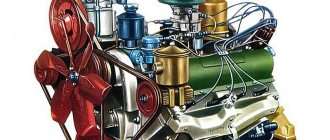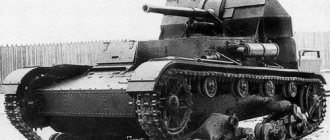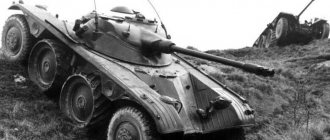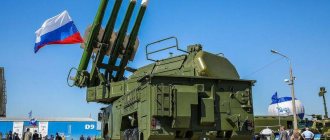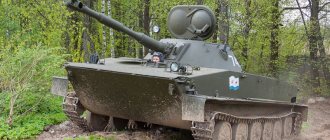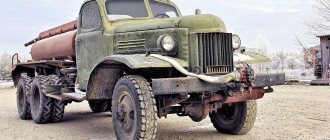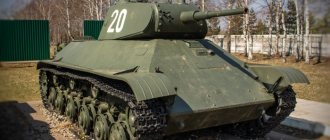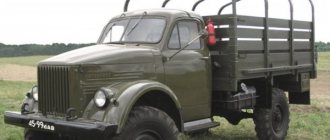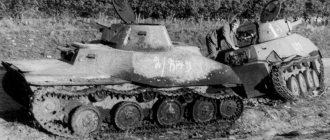CAROLD.RU - Site about retro cars and technology.
GAZ-53 is a Soviet truck, part of the third generation GAZ family of medium-duty trucks. The GAZ-53 truck was mass-produced from October 1961 to 1967 under the symbol GAZ-53F, from 1965 to 1983 under the symbol GAZ-53A and from 1983 to January 1993 under the symbol GAZ-53-12 by Gorkovsky car plant. GAZ-53 with subsequent modifications is the most popular truck in the territory of the former USSR, the so-called. "workhorse" of the Soviet economy. The total production of GAZ-53 amounted to over 4 million vehicles, and GAZ-52 - 1,006,330 units.
Chief designer - A. D. Prosvirnin. Leading designers: A. I. Shikhov, V. D. Zapoinov. Leading designer of the V8 engine is P. E. Syrkin.
The background to the appearance of the GAZ-53F is unofficially associated with the XXII Congress of the CPSU that took place in 1961, by the opening of which the plant was obliged to begin production of the new GAZ-53 truck. However, due to the fact that by that time the V-shaped 8-cylinder engine had not been mastered in production, it was necessary to install a “six” boosted to 82 hp. thanks to an increase in compression ratio to 6.7. Also, the hypoid rear axle was not mastered, so they used the usual one from the GAZ-51A, but with the main pair from the GAZ-63 (i=7.6; for the GAZ 51A i=6.67). This made it possible, to some extent, to maintain the dynamics of the car with a payload capacity increased to 3500 kg. Due to the increased load capacity, 8.25-20 tires and three-hole rims were installed. The first production sample of the GAZ-53F was assembled on September 23, 1961, and on October 14 of the same year, a pilot batch of 25 vehicles left the main assembly line. Until March 1962, the GAZ-53F was assembled periodically - in small batches. The load capacity of the GAZ-53F was determined by the plant at 3500 kg until December 1964, but then it was reduced to 3000 kg.
Serial production of the GAZ-53 was planned for 1962, but its production was hampered by the lack of a finished engine. Large-scale assembly of engines was mastered only at the end of October 1963.
Since June 1964, the GAZ-53 truck became the base model of the Gorky Automobile Plant. This is a modification of the GAZ-53F car and a transitional model to the GAZ-53A. Load capacity 3 tons. In essence, it was a GAZ-51A chassis with a wheelbase extended to 3700 mm and with a GAZ-52 truck cab - a kind of symbiosis of old and new, a logical transition from the 2.5-ton GAZ-51A to the 4-ton GAZ -53A. Unlike its predecessor, it has a new engine with a power of 115 l/s, thanks to which the maximum speed of the car has increased to 85 km/h.
When designing the GAZ-52, several engine options were considered, including an in-line prechamber engine and a V-shaped carburetor “six”. They planned to install this engine on the GAZ-53. However, due to difficulties in developing a new engine, the designers turned their attention to a new V-shaped eight-cylinder engine for the new GAZ-13 large class passenger car. With this engine, it became possible to increase the payload of the truck to four tons, which, in turn, entailed strengthening the frame and suspension, increasing the cargo platform, installing new tires, changing the braking system and steering.
The engine had a displacement of 4.25 liters, a compression ratio of 6.7 and developed a power of 115 hp. at 3200 rpm. The design features of the engine include a lubrication system with a centrifugal oil filter (centrifuge), an open crankcase ventilation system, and wet-type cylinder liners. Unlike the GAZ-51A, to transmit the increased torque, a reinforced single-disc clutch and a new gearbox with synchronizers in 3rd and 4th gears, as well as a new driveshaft were used.
Initially, the GAZ-53 had a payload limited to three tons. To avoid overload, the “3t” signs were painted large on the side sides of the body with white paint. Such cars were produced in small quantities in 1964 and in the first half of 1965.
A year later, from June 1965, the GAZ-53A began to roll off the assembly line. It, like the GAZ-53, was equipped with a V-shaped overhead valve 8-cylinder gasoline engine. The carrying capacity of the new machine has increased to 4 tons. The large volume of the body and lattice side sides ensured full use of the carrying capacity, regardless of the type of cargo. The difference from the previous model was a reinforced front axle, a new driveshaft and steering mechanism. The length of the frame was reduced, the towing device was removed, and to increase cross-country ability, tires with a special tread pattern were installed.
The GAZ-53-05 tractor was also created, designed to work with a 3-ton trailer. Another modification of the GAZ-53A car is the GAZ-53A-016 - a vehicle with additional equipment and two fuel tanks with a total capacity of 195 liters and a total curb weight of 3325 kg. But, already starting in 1966, the plant began to produce GAZ-52-03, with a carrying capacity of 2500 kg, but with a long (3700 mm) wheelbase, like the GAZ-53. On the basis of this truck, the Gorky Automobile Plant built the GAZ-53B-02 chassis for the Saransk dump truck plant.
In 1973, the GAZ-53A and its modifications were certified for the assignment of the state Quality Mark. A gray plastic emblem was attached to the radiator trim between the headlight and sidelights. But subsequently, in 1982, the emblem disappeared from the cladding. Cars also began to be equipped with side turn signal repeaters, which were located on the wings of the cab.
Since 1983 The production of the modernized GAZ-53-12 with a carrying capacity of 4.5 tons was mastered. Changes affected the engine and radiator lining. Also, the modification of this truck GAZ-53A-016 (produced 1966-1983), intended for the needs of the armed forces of the Soviet Union, coped well with the functions assigned to it. In the last years of their production (1984-1992), gasoline-powered models were supplemented with modifications that used compressed natural and liquefied gases as their fuel. – We are talking about GAZ-53-19 and GAZ-53-27 trucks.
It was no coincidence that this truck was called nothing less than the “workhorse” of the economy of the Soviet Union - it was present in almost all spheres of the national economy of a socialist country: agriculture, construction, freight transportation, etc. Among other things, it is impossible to overestimate the merit of the GAZ-53 in the process of developing virgin lands in Central Asia (the steppes of Kazakhstan), initiated by the then Secretary General of the USSR N.S. Khrushchev - this “worker” transported grain crops, and was perfectly suited to the local climatic conditions.
Various modifications of the GAZ-53 truck were successfully used not only on the territory of the Soviet Union - as part of fraternal assistance, supplies of these vehicles were established to countries that were part of the so-called bloc of socialist states: East Germany (GDR), Hungary, Czechoslovakia, Romania, Yugoslavia, Vietnam , Laos, Cuba, Mongolia and North Korea. As for the last 3 countries, here and there you can still find properly working GAZ-53s. Deliveries of GAZ-53 trucks were also established to neighboring Finland, despite the fact that it was not a socialist country. The Soviet truck has proven itself well in the local climatic conditions.
Modifications of GAZ-53
* GAZ-53F (from October 1961 to January 1967) - flatbed truck and chassis with a forced GAZ-51 engine with a power of 82 hp, a GAZ-51 rear axle with a gearbox from a GAZ-63 (i = 6.7 ), load capacity 3.5/3.0 t, maximum speed up to 75 km/h;
Overall dimensions of GAZ-53
carold.ru
About the history of the legendary truck and its features
The first generation of trucks was produced in the 2nd half of the 50s. According to the project, the GAZ family was distinguished by a load capacity of 1.5-2.5 tons and common parts. The 51st test car was supposed to be replaced by the 52nd model.
History and purpose
The 52nd modification was intended for use in urban and rural conditions, so smoothness, maneuverability and cross-country ability were important. By the mid-1950s, employees of the Gorky Automobile Plant developed several samples with a modified hood, which were not accepted for serial production.
At first, they wanted to use a 6-cylinder engine with a pre-chamber block head for the truck. At the same time, we were working on the project of a V-shaped internal combustion engine with 6 cylinders with a volume of 3.75 liters and a power of 110 horses. The design was not implemented; instead, a derated engine from the Chaika was used.
The powerful engine required a change in load capacity to 4 tons, which meant a new frame and suspension. The model was given the name GAZ-52A, which was replaced by LAWN modification 53.
The new motor took a long time to develop, but the plant’s commitment to time the release to coincide with the beginning of the XXII Congress of the CPSU led to the creation of a transitional version. The GAZ-53F was equipped with a power unit from the old model and a lower valve type engine.
The production of the truck began only in 1964. The car did not leave the assembly line until 1993 and went through several modifications:
- in 1964 - production of ZMZ-53 models with a load capacity of 3 tons, a V-shaped engine and a hypoid rear axle. Discontinued and replaced by GAZ modification 53A;
- in 1966 - the Gorky Automobile Plant launched models 53N for army needs. The car received a pre-heater, anti-slip chains, saws, a towing cable, a radiator cover and an additional fuel tank;
- in 1973 - the car received turn signal repeaters and the Quality Mark between the headlight and sidelights;
- in 1978 - the dump truck was equipped with stampings on the roofs, the cabin began to be painted blue;
- in 1982 - the Quality Mark was removed from the facing part;
- in 1983 - GAZ modification 53-12 changed radically - the dump truck could transport loads up to 4.5 tons, received a new engine, reinforced frame, springs and suspension;
- in 1984 - a simplified bumper without stamping was installed, light gray and protective were added to the color scheme;
- in 1986 - rear lights were replaced, two-color sidelights were installed, emergency lights, a brake cylinder, an instrument panel, contactless ignition, hydraulic vacuum brake boosters, and separate brake circuits appeared.
Interesting to know! Production of the dump truck stopped completely in 1997.
Creators
The chief designer of the car was A. Prosvirnin, the leaders were B. Shikhov, V. Zapoynov. The design of the engine for ZMZ-53 was developed by P. Syrkin.
Interior and exterior of GAZ-53
At one time, the GAZ truck version 53 was modern. It has a streamlined shape and a one-piece cladding with places for headlights. A strong and reliable frame made it possible to transport large loads.
The tank was located under the driver's seat. The bay hole is located behind the cab and is located near the driver's door. This ensured the convenience of installing LPG under the body.
The car was started by an electric starter with a retractor relay. The heating system worked well. The windshield wipers were electrically powered.
The seats for the driver and passengers of the truck have a one-piece design. The cabin is spacious, it could comfortably accommodate people in winter clothes. There are special compartments for tools, parts, and personal accessories.
Car export
The truck was exported to countries friendly to the USSR - Romania, Poland, East Germany, Yugoslavia, Hungary, Czechoslovakia, Finland, North Korea, Cuba, Laos, Vietnam, Mongolia.
Interesting to know! Assembling a dump truck from 1983 to 1991. was engaged in Bulgarian. The series was distinguished by a diesel engine produced under license from the English company Perkins.
GAZ-53/52. Forced and diesel: detroit_diesel8
I have quite a few pleasant memories associated with the eight-cylinder GAZ-53. This was my first car that I learned to drive. At first it seemed scary and difficult to control. From the cabin with a huge hood it was not very visible. And to reverse, you had to open the door and stick your head out. The steering without power steering is heavy and it was impossible to turn it on the spot. A gearbox without synchronizers blew my fragile brain away. It was even scary to switch. The instructor, as usual, was an asshole and, apart from swear words, didn’t seem to know any others. But it was fun.
But then it turned out that it wasn’t me who should be scared. And I myself am scary, driving a big and heavy crap with a strong bumper with a long hood and a narrow windshield from which you look at everyone like shit from the viewing slot of a tank. And the box stopped annoying and the steering wheel was no longer so heavy and the dashboard made of painted iron began to please, because it was not the same as on cars (there is plastic). In general, everything turned out well, especially considering the fact that the driving school did not force us to repair the lawn. I studied the history of the GAZ-53 from Shugurov’s book “Cars of the Land of the Soviets,” which I leafed through, because there was nothing else. The situation with auto literature in the USSR was generally bad. Especially with foreign literature, although luxury Swiss car catalogs sometimes appeared in “Foreign Literature” for 25 rubles. Not for long, of course.
Prospectus for GAZ-53A from my collection. I’ll say right away that what follows will mostly be pictures from other people’s collections and from the Internet.
Shugurov’s illustrations were lousy, but still better than the “postage stamps” in Science and Life. Now, of course, there is simply incredible abundance. But the note will not be about this, but about the LAWN.
Pictured is GAZ-56 (1960)
The story began in the mid-50s, when Gorky Automobile engineers began work on a successor to the GAZ-51. A unified family was being prepared with a carrying capacity of 1.5 tons, 2.5 tons, and 4 tons. They were called GAZ-56, GAZ-52 and GAZ-53, respectively. The first one received a motor from Volga, the power of which, as it turned out during testing, was not enough. The second was a modernized GAZ-51 with almost the same engine, and the third was supposed to be equipped with a gasoline V8.
Initially, the slope of the windshield pillar was not the same as on production models. Aerostyle was raging in the USA and Soviet designers wanted to keep up with the fashion for panoramic windshields. They even issued brochures based on the prototypes, just like in America. Nowadays it’s a great success to meet such people. I haven't had any luck yet.
In addition, it was planned to equip the promising GAZ-52 with an interesting engine with pre-chamber-torch ignition and three valves per cylinder. Through the third valve, a rich mixture was supplied to the spark plug, and from there, a “torch” ignited the charge of the lean mixture in the cylinders. This promised increased efficiency. Alas, the design turned out to be capricious and things did not go beyond the experimental batches of the GAZ-52F.
A later example of the GAZ-52 with the usual tilt of the stance.
Alas, a replacement for the weak motor from the Volga was not found, the prechamber engine did not take root, and the G8 turned out to be a tough nut to crack and it was not possible to quickly put it on the conveyor. Then, as a temporary measure, the GAZ-53F went into production with the old “six” from the GAZ-51, boosted from 70 to 82 hp. with a volume of 3.48 liters. The compression ratio increased from 6.2 to 6.7, and the speed was increased from 2800 to 3200. The load capacity was reduced to 3 tons.
Assembly began on September 23, 1961, and on October 14 of the same year, a pilot batch of 25 cars left the main assembly line. Until March 1962, the GAZ-53F was assembled in small batches.
Interesting fact: the load capacity of the GAZ-53F was determined by the plant at 3500 kg until December 1964, but then it was reduced to 3000 kg. In January 1967, production of the GAZ-53F was discontinued.
Another GAZ-53F in a smart two-tone paint job
GAZ-52 from the experimental batch of 1961-1966
In 1964, production of the GAZ-53 with a V8 finally began. The working volume was 4.25 liters, the compression ratio was 6.7 and developed a power of 115 hp. at 3200 rpm. The gearbox received synchronizers in 3rd and 4th gear. They did not differ in reliability and durability. That’s why drivers usually drove like they weren’t there. It is curious that I studied on the GAZ-53-12 model from the mid-80s, which, according to the instructor, simply did not have synchronizers installed at the factory. Externally, the GAZ-53 was not very different from the GAZ-53F. Considering the smooth transition, I think the first games were no different.
A page from the Autoexport catalog of 1973. Pay attention to the power in SAE. More impressive than DIN.
In 1965, a modernized GAZ-53A was released with a new steering wheel, driveshaft, reinforced chassis, etc. The cabin has smoothly changed its design. The sidelights became headlights, the lining began to resemble a smile. Load capacity was increased to 4 tons.
It's funny that in 1973 the GAZ-53A and its modifications received a “quality mark”. The plastic badge was placed on the right side between the headlight and the sidelight (heavily retouched in the photo). In 1982, the emblem disappeared from the cladding (and deservedly so). In 1966, the GAZ-52-03 appeared with a long wheelbase of 3700 mm (like the 53rd), outwardly very similar to the GAZ-53A. For some time, both cars were equipped with the old cladding. The engine of the GAZ-52 was from the GAZ-51A, boosted to 75 hp. Since 1975, the GAZ-51A was replaced by the short GAZ-52-04 (wheelbase 3300 mm).
Garbage truck M-30
Another page from Autoexport. In Kyiv, such trash cans “ran out” in the late 80s.
Modernization option for GAZ-53A 1977.
But this GAZ-53-12 (1984) went into production. Changes were made to the engine and even to the interior. Later models received plastic black mirrors.
Abroad, in capitalist countries, the GAZ-53A was in limited demand due to its voracious gasoline engine. True, dealers, especially Finnish ones, resolved the issue. They installed Perkins diesels (England). The Bulgarians, by the way, installed diesel engines of their own production, licensed by the same company Perkins
In addition, the Finnish Konela installed other platforms (optional), painted them in “fun” colors and redesigned the “face”
Or they added their own chrome emblem. It turned out well. At least in the 60s.
detroit-diesel8.livejournal.com
GAZ-53: the story of a truck from childhood
The GAZ-53 car represents the third generation of medium-duty trucks produced by the Gorky Automobile Plant. The first production models of this truck rolled off the assembly line in 1961. The car turned out to be so successful that its production continued until 1993. The GAZ-53 car has become a worthy successor to such cars as the GAZ-AA and GAZ-51.
Truck design features
Over the 32 years of production, the vehicle has undergone many upgrades, and three of them brought changes in the designation of the truck:
- GAZ-53F was the very first modification. Produced from 1961 to 1967. At that time, the design of the third-generation truck cabin looked unusual and modern;
- GAZ-53A was produced from 1965 to 1983;
- From 1983 to 1993, the GAZ-53-12 was produced.
The GAZ-53 cabin of each of the three different modifications had its own characteristics:
- For cars of the first years of production, which were assembled before the modernization of 1967, the cabin was visually similar to the ZIL-130 cabin. The headlights are located on top, and the sidelights are located on the bottom;
- The 1965 modernization had the most original appearance. It received sidelights above the main headlights and an original front cladding with a characteristic “smile”;
- The latest modernization has received elongated holes in the radiator grille and sidelights, which have moved significantly to the edge. The car was produced in this form until 1993.
Soon the classic type sidelights were replaced with combined ones, which had two bulbs.
Even now, many GAZ cars of this modification travel on the roads of the CIS; you can often see the GAZ-53 diesel. These are homemade modifications, since the Gorky Automobile Plant practically did not install diesel engines on third-generation trucks. Only in the early 1990s a small number of diesel trucks with Minsk-developed engines were produced, but it is almost impossible to see them on the roads.
The GAZ-53 truck became the most popular vehicle throughout the Soviet Union. Over the years of production, the plant was able to produce more than 4,000,000 units of such trucks in various modifications. The third generation Gorky truck has the following features:
- The cabin is all metal. Since problems with metal existed only until the early 1950s, all GAZ-53 cabins were made of metal;
- The salon is small in size, despite this, it could accommodate two passenger seats;
- The ignition of the GAZ-53 was with an electric starter;
- The wipers also operated electrically;
- There was a powerful interior heater, which kept the driver from freezing even in winter.
Thanks to the electric starter drive, the ignition of the GAZ-53 worked flawlessly; the main thing was to monitor the condition of the battery. Some drivers complained of excessive cabin noise from the engine. This was eliminated by installing homemade sound insulation.
Main modifications of GAZ-53
On the basis of the GAZ-53, many different modifications were created, ranging from flatbed trucks to various army equipment. The powerful frame of the GAZ-53 withstood the weight of the heaviest installations. Here is a list of the main modifications of the GAZ-53:
- For the first 1.5 years, the Gorky Automobile Plant produced the classic modification of the GAZ-53F. It was equipped with a ZMZ-53 engine developing 115 hp;
- GAZ-53A was the next modification of the truck. At its base, various vans, aerial platforms, on-board vehicles and a GAZ-53 dump truck were produced;
- GAZ-53-016 was created specifically for army needs. It had an additional fuel tank and pre-heater;
- GAZ-53B-02 is a specialized chassis for dump trucks. The rear axle of the GAZ-53 coped well with the loads on construction sites when it was not overloaded. Unfortunately, Soviet drivers rarely paid attention to the actual carrying capacity of the car, loading according to the principle “if it fits, then it’s possible.” It is for this reason that a legend arose that the GAZ-53 gearbox, and the rear axle itself, are parts of poor quality and prone to failure;
- GAZ-53-05 was a truck tractor, but its production was never launched at the plant;
- GAZ-53-40 was a long chassis without a cabin. Used to create various specific machines at its base;
- GAZ-53-50 was the highest quality truck in the line, as it was produced mainly for export to hot countries. Even the rear axle of the GAZ-53 in this case was selected to be of the highest quality;
- The last major modernization of the GAZ-53-12 received the ZMZ-511 engine, which developed up to 120 hp.
Traditionally, the Gorky Automobile Plant produced a limited edition modification of the GAZ-53-27, which ran on natural gas. In addition, many different vans and special vehicles were produced on the GAZ-53 chassis of all modifications.
At one time, these trucks prevailed on collective farms and on racks in the USSR, and even in the 90s, the car was popular due to its low price and ease of maintenance. The main thing was to monitor the condition of the rear axle of the GAZ-53 and service it in a timely manner, then the car did not let down. The overload affected not only it, but also the springs of the GAZ-53.
Although GAZ-53 engines are now considered unreliable, they easily lasted 400,000 km without major repairs. If you now fill this engine with high-quality foreign oil and do not overheat it, then the interval before major repairs can easily be doubled.
GAZ-53 trucks were exported in huge quantities to all countries of the socialist camp. There were many cars in Yugoslavia, the Czech Republic, the GDR, Hungary, Poland and Finland. Despite its enormous popularity, in the early 1990s the truck became very outdated both externally and technically, so it was soon replaced on the assembly line by the fourth generation medium-duty vehicle, the GAZ-3307.
Technical characteristics of GAZ-53
GAZ-53 has the following main performance characteristics:
- Vehicle length – 6,395 mm;
- Height – 2,190 mm;
- Width – 2,280 mm;
- Ground clearance – 265 mm. Compared to the GAZ-66, this ground clearance is too low, but in combination with the powerful rear axle of the GAZ-53 and gable wheels, the car copes well with driving on rural roads;
- The vehicle's carrying capacity is 4,500 kg;
- The maximum speed with a full load can reach 90 km/h.
As for the volume of the gas tank and fuel consumption, the tank holds 90 liters. If you believe the passport data, the fuel consumption of the GAZ-53 should not exceed 24 liters per 100 km. The actual data that Russian drivers managed to achieve is about 27 liters of fuel. A fully loaded truck consumes at least 30 liters of gasoline per 100 km.
GAZ-53 engines and their features
Over all the years of production of the GAZ-53, several types of gasoline engines were installed on it:
- The very first modifications received the GAZ-11 engine;
- After modernization in 1964, it was replaced by ZMZ-53;
- In 1983, the GAZ-53-12 engine appeared;
- In the early 1990s, the carburetor ZMZ-511 began to be installed on the GAZ-53.
A small number of diesel GAZ-53s with the MMZ D-245 engine were also produced in the early 1990s.
Transmission and chassis GAZ-53
The GAZ-53 was equipped with a four-speed gearbox. It worked in tandem with a dry clutch equipped with a hydraulic drive. In order to change gears, it was necessary to use the clutch twice, since the gearbox was not synchronized.
The GAZ-53 brake system was dual-circuit - there were separate circuits on the front and rear axles. The rear axle of the GAZ-53 did not cause any problems if the driver did not overload the truck and periodically maintained and adjusted the axles. In addition, due to constant overloads, the leaf springs of the GAZ-53 burst, which also affected the condition of the rear axle and axle shafts.
Advantages and disadvantages of the truck
The third generation truck was produced over several decades, as it had a number of undoubted advantages:
- Reliability and maintainability;
- Power steering;
- Possibility of repair in any conditions;
- Long engine life.
In addition to its advantages, the GAZ-53 also has disadvantages:
- Unreliable grip;
- The springs were sensitive to the slightest overload, especially on bad and broken roads;
- The nuts on the driveshaft often came loose, so it was recommended to check and tighten them periodically.
In addition, the cabin was not very spacious, which made long runs tiresome.
The GAZ-53 car is still in operation both in Russia and in a number of other CIS countries. The GAZ-3307 model was never able to surpass it in popularity.
If you have any questions, leave them in the comments below the article. We or our visitors will be happy to answer them
warways.ru
History of creation
The model entered mass production in 1961. The manufacturer completed production of trucks in 1993. Over the years, several modifications have been released. They differed in the characteristics of the unit and the type of chassis. The first cars were produced with a 6-cylinder power unit. It had an in-line arrangement of working cylinders and a liquid cooling system. Afterwards, a gasoline unit with 8 working chambers, the maximum power of which was 120 horsepower, began to be installed on the GAZ-53.
Description and device
The car is made on the basis of a frame consisting of two channels connected by cross members. The engine compartment is located at the front of the truck. Gas-53 has a 4 x 2 wheel arrangement. The drive from the gearbox is to the rear axle. The chassis type differs depending on the version. The manufacturer equipped the truck with a mechanical steering column. Its gearbox includes a worm gear. No hydraulic booster is provided. This requires the driver to exert great physical effort when turning the steering wheel.
The GAZ 53 truck was produced in several modifications
The electrical circuit of the GAZ 53 car is built on a single-wire principle. The negative contact is the car body, it is connected to the battery. Power sources are a 12-volt battery and a belt-driven generator. While the engine is running, the battery is charged. The body of the Gorky Automobile Plant model was manufactured in several versions:
- Wood. The front board is rigidly fixed to the base. The side and rear panels are mounted on metal hinges. Loading and unloading is carried out from any of the three sides.
- Metal. Installed on a dump truck. The back and side sides are movable. Unloading is carried out on the side or backwards. In the center of the bottom of the metal body there is a bracket designed for mounting a hydraulic cylinder.
- Metal closed type. The body is equipped with side or rear doors. This model is widely used for transporting food products.
On the basis of the GAZ 53, aerial platforms, fuel tankers, fire trucks, etc. were manufactured. The manufacturer also produced vehicles intended for the needs of the army.
History Gas 53
November 7, 2008 – 12:01
Model reviews For those who remember the old: GAZ-53 and GAZ-66
Many years have passed since the last GAZ-66 car rolled off the assembly line of the Gorky Automobile Plant (July 1999), and even earlier the serial production of the GAZ-53 modification ceased (January 1993). But the idea of the reliability, cross-country ability, and irreplaceability of these particular cars in certain areas of activity is firmly entrenched in the minds of people, especially the older and middle generations. The names “shishiga” and “fifty-third lawn” alone are so well known that these cars, without exaggeration, can be called a legend of the late twentieth century. Therefore, our company still receives many applications for the purchase of these particular cars, indicating a specific modification: GAZ-66 and GAZ-53, which, in turn, inspired us to create this information article.
Time does not stand still, and the Gorky Automobile Plant, keeping up with the times, has long changed the model range of serial trucks. However, do not be discouraged - all changes were aimed only at increasing comfort and improving technical characteristics, while maintaining such important indicators as maneuverability, load capacity and maintainability. And this will be discussed in more detail, but a little later, but now a short excursion into history.
With a clear conscience, the GAZ-53 can be called a kind of “workhorse”, which for many years tirelessly pulled its “shoulder” throughout the entire Soviet Union. This vehicle belongs to the family of medium-duty trucks, and was mass-produced under various modifications from 1961 to 1993. Accordingly, depending on the modification, there were differences in carrying capacity (from 2.5 to 4.5 tons), appearance, wheel arrangement, and so on. One thing was constant - the GAZ-53 car was the main worker in any sphere of the economy. You don’t have to look far for an example, just remember your favorite “Soviet cinema”, where the history of simple human destinies was inextricably linked with labor: construction teams, collective farms, road construction, and everywhere in the foreground there was the legendary “lawn”...
More details at: www.gazavtomir.ru
www.alfanoff.ru
GAZ-53: technical characteristics, varieties, operating features
In the 60s of the last century, the plant, today called GAZ Group, began producing medium-duty trucks.
New power units, transmission mechanisms, cabin and body, and controls were installed on the trucks.
Models of the 52, 53, 66 series formed a line of universal trucks, which, in the interests of the national economy, provided transportation in industry, for agricultural and construction needs.
Modifications and release history
The car was the most popular truck of the Union republics. There were 4 million conventional, dump truck and specialized vehicles operating on the country's roads.
In 1961-1967 GAZ-53F was produced. Six-cylinder 82 liters. With. The GAZ-11 engine with a four-speed gearbox ensured the transportation of 3,500 kg of cargo, consuming 24 liters of low-octane gasoline for a run of 100 km.
By the planned release time of the model, the V-shaped eight-cylinder power unit was not in production.
For the 53F, the six-cylinder GAZ-11 was boosted, increasing the compression of the mixture. There was no ready-made hypoid rear axle, so they installed a mechanism with bevel gears from the 51A model (the car is shown in the photo).
Objectively, in terms of its technical characteristics, the GAZ-53F car was a transitional model between the 51A series (with a load of 2,500 kg) and the SAZ-53B series (with a load capacity of a ton more), which was achieved by an increased base to 3.7 m and new tires 8 ,25-20, mounted on steel disks.
The car was used not only as a dump truck, but also a sewage truck, fuel trucks and milk tankers were common.
The GAZ-53 was not a complete design; due to frequent failures of parts and mechanisms, it was not popular among drivers and repair workers of motor transport enterprises. The truck with a clearly weak engine and an unreliable axle was produced until 1967.
From 1964 to 1983, models of the 53 and 53A series with a cargo load of 3,500 and 4,000 kg hit the roads. More powerful power unit ZMZ-53 with 115 hp. With. ensured an increase in the speed parameter to 85 km/h with gasoline consumption of 25 liters per 100 km.
Differences between the 53A line and the 53
The car models have the following differences:
- reinforced front axle;
- new cardan design;
- more reliable steering gear design;
- new radiator grille;
- turn signals are duplicated by repeaters on the wings of the cabin;
- the presence of electric windshield wipers;
- cabin heating.
In 1973, model 53A was awarded the USSR State Quality Mark. Expanding the functionality of the vehicle, the production of chassis 53 01 for covered bodies and special equipment was launched.
Chassis 53 02 was a platform for the use of a dump truck body and was equipped with a power removal device for a hydraulic pump.
Trucks of models 53 50 and 53 70 were exported. The vehicles were readily purchased in Belgium, Finland, and in socialist countries. In Bulgaria and Cuba, trucks were assembled from kits supplied from GAZ.
Model 53 12 was produced from 1983 to 1992, as a further development of the 53rd line. The truck was equipped with an eight-cylinder ZMZ-511 engine.
Power parameter is 120 hp. With. made it possible to increase the load to 4.5 tons, and the speed indicator to 90 km/h.
Gasoline consumption increased to 30 liters, but provision was made for installing equipment for refueling with liquefied or compressed gas.
Technical characteristics of the basic on-board vehicle GAZ-53:
| Index | Unit change | Meaning |
| Production period | 1964-1983 | |
| Limit dimensions (length, width, height) | mm | 6 395, 2 380, 2 220 |
| Fuel consumption | l/100 km | 24 |
| Total places | 3 | |
| Load | kg | 4 000 |
| Fully loaded weight | kg | 7 400 |
| Base between wheel axles | mm | 3 700 |
| Ground clearance is minimal | mm | 265 |
| Speed | km/h | up to 85 |
| Power unit | ZMZ-53 | |
| Clutch mechanism | one disk, dry type, with lever drive | |
| checkpoint | by four steps | |
| Rear axle main gear | single, conical, hypoid | |
| Steering column | globoid worm and three-comb roller | |
| Tire size | 8,25-20 | |
| Brake device | drum-type mechanism on all axes, with hydraulic drive |
Diesel car engine
The engine on the GAZ-53 (ZMZ-53) truck is a V-shaped, eight-cylinder (two rows of four cylinders), carburetor type, operating on a four-stroke cycle.
The working volume of the internal combustion engine cylinders of the GAZ-53 car is 4.25 liters (with a cylinder cross-sectional size of 92 mm and piston strokes of 80 mm).
Technical specifications for power 115 hp. With. The GAZ-53 engine is started using a starter.
The nominal crankshaft revolutions per minute are 3,200. The mixture compression ratio is 6.7.
Advantages and disadvantages
The vehicle has both advantages and disadvantages. This should be taken into account when choosing a truck. The truck has the following advantages:
- Unpretentiousness to fuel quality. The engine runs stably regardless of the quality of gasoline.
- Easy to operate and repair. A person who does not have special knowledge and experience can troubleshoot problems. Most problems can be corrected in the field.
The disadvantage of the car is the high noise level in the cabin when driving and the lack of a hydraulic booster . At medium and high speeds the engine produces a high level of noise. This requires the installation of additional sound insulation. Due to the lack of power steering, the driver must make great physical efforts to control the car.
